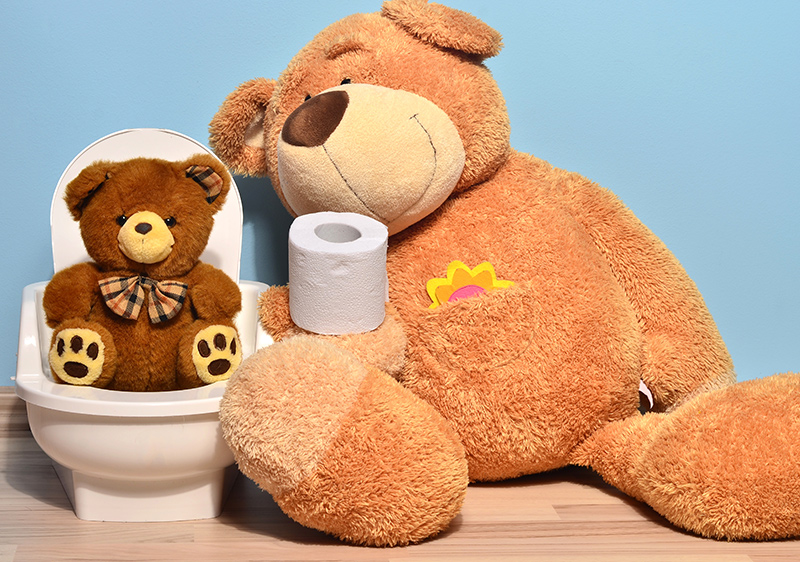Toilet Training
Toilet training may be considered the most challenging process that parents will encounter with their child during the early stages of his or her life. It is an individualised developmental process that all children will progress at their own pace and temperament, not the child’s chronological age. This goal may only be achieved when the child is ready and willing.
Some of the signs to look for to determine whether the child is ready include:
- the ability to walk to a potty,
- follow simple commands,
- remain dry for several hours,
- take off their own clothes,
- show a desire for independence,
- curiosity about the toilet,
- talk about pee-pee and poo-poo, and
- enjoys imitating their parents.
As mentioned above, toilet training should be a natural result of the child’s developmental readiness. Just like any learning process, toilet training affects the development of the child as a whole and it is important that the child has the necessary physical, social, emotional and cognitive skills to begin. The signs of readiness are crucial for the training to be successful and to ensure the child gains a sense of independence and self-confidence.
In the course of the toilet training process, the child must obtain body awareness and be able to associate bodily sensation to the result that follows, poop or pee. After mastering that skill, he or she must learn to visualise what they intend to do (use the toilet), start using it, and stay in place long enough to complete. This involves both memorisation and attentiveness.
Children with intellectual disability or developmental delay are best toilet trained one step at a time. It is important to keep them motivated and achieve success gradually. The time it takes to achieve success ranges from a few months to a year or more. Children are likely to be resistant to adopting this new habit. However, it is important to insist that they try. They will be expected to visit the bathroom at predictable times and may even become upset if it does not happen. It may be difficult for both parents and the child as they are embarking on a difficult developmental task.
The key to toilet training is perseverance, consistency and the ability to break the process into manageable tasks. The aim is to go in phases and reward each phase, then raise the standard as these objectives are reached. Any habit can take weeks to overcome. Although toilet training is challenging, it is worth the effort. The child will have a new sense of individuality and confidence.
Routine and steps
Firstly, parents and the caregivers will have to determine the words to be used in carrying out the plan. For example, are you going to use the word, “toilet”, “potty”, “bathroom”, etc? What word is to be used for body parts? What word is to be used for urine or bowel movements? – “wee” or “poo”. It is important to use the same words to avoid confusion for the child. If the child is older, it is essential that age-appropriate words are used during training.
It is necessary to break down the steps of toileting as you are teaching a routine. Steps include from entering the bathroom, closing the door, pulling down pants, sitting on the toilet (caregiver can determine if it is best for a male to stand or sit initially), urinating or defecating, washing, flushing, pulling up pants, washing hands, drying hands to opening the door. The advantage of breaking the process down into individual steps is to enable them to master it one step at a time. It also enables them to view and understand the entire process. Parents and caregivers should avoid pushing children too quickly from one step to the next.
Visual supports
For children who are visual learners, their learning may be supported by visual cues. Parents and caregivers may create a visual support or schedule to show them the steps on how to use the toilet. Picture Exchange Communication System (PECS) or other visual aids such as attached may be used. This schedule should be stuck on a wall close to the toilet or potty to remind the child of the steps.
It is important to go over the schedule with your child 2-3 times a day.
Everyone who does toileting with your child will need to know and follow the schedule to ensure that training is consistent.
Praises and rewards to help with toilet training
To encourage your child, parents and care givers may praise and reward them as they learn each step involved in using the toilet.
You could try:
- descriptive praise – for example, ‘Ali, well done for sitting on the toilet!’
- nonverbal praise, gestures (clapping), high fives, or signs (thumbs up)
- a favourite activity – for example, playtime with a favourite toy
- a star on a sticker chart.
Once your child has made progress on a particular step, you may stop using activities and toys as rewards. It is essential to keep praising your child to enable them to develop confidence.
Regression
A child who has been toilet trained may experience setbacks. This may be due to:
- Illnesses, diseases, accidents or significant physical influences
- Medication changes
- Changes in food or fluid consumption
- Changes in sleep patterns
- Significant changes in daily routines
- Changes in the family structure or home environment
- Changes regarding school, classmates, assigned classes, performance demands, or significant persons in the school environment
- Increased levels of stress or anxiety[1]
In the event of a setback, parents and caregivers should avoid responding with negative emotions. Instead, they should return to a training plan.
By Kala Rani Naidu & Sunitha Sivakumaran
Reference(s):
[1]Wheeler, Maria, M. ED; Toileting Training for Individuals with Autism or Other Developmental Issues, Future Horizons, 2007.

